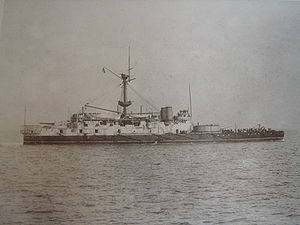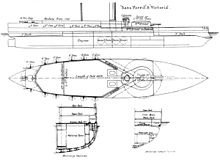
An ironclad is a steam-propelled warship protected by iron or steel armor plates, constructed from 1859 to the early 1890s. The ironclad was developed as a result of the vulnerability of wooden warships to explosive or incendiary shells. The first ironclad battleship, Gloire, was launched by the French Navy in November 1859 – narrowly pre-empting the British Royal Navy, though Britain built the first completely iron-hulled warships.

HMVS Cerberus is a breastwork monitor that served in the Victoria Naval Forces, the Commonwealth Naval Forces (CNF), and the Royal Australian Navy (RAN) between 1871 and 1924.
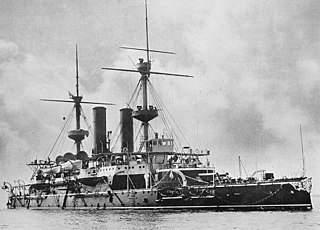
HMS Hood was a modified Royal Sovereign-class pre-dreadnought battleship built for the Royal Navy in the early 1890s. She differed from the other ships of the class in that she had cylindrical gun turrets instead of barbettes and a lower freeboard. She served most of her active career in the Mediterranean Sea, where her low freeboard was less of a disadvantage. The ship was placed in reserve in 1907 and later became the receiving ship at Queenstown, Ireland. Hood was used in the development of anti-torpedo bulges in 1913 and was scuttled in late 1914 to act as a blockship across the southern entrance of Portland Harbour after the start of World War I.

HMS Dreadnought was an ironclad turret ship built for the Royal Navy during the 1870s. Construction was halted less than a year after it began and she was redesigned to improve her stability and buoyancy. Upon completion in 1879, the ship was placed in reserve until she was commissioned in 1884 for service with the Mediterranean Fleet. Upon her return 10 years later, she became a coast guard ship in Ireland for two years. The ship then became a depot ship in 1897 before she was reclassified as a second-class battleship in 1900. Dreadnought participated in the annual fleet manoeuvres for the next two years before she became a training ship in 1902. The ship was taken out of service three years later and sold for scrap in 1908.
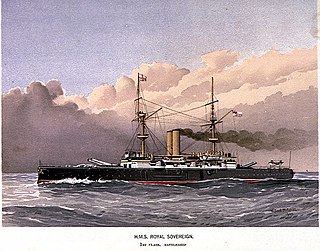
Pre-dreadnought battleships were sea-going battleships built from the mid- to late- 1880s to the early 1900s. Their designs were conceived before the appearance of HMS Dreadnought in 1906 and their classification as "pre-dreadnought" is retrospectively applied. In their day, they were simply known as "battleships" or else more rank-specific terms such as "first-class battleship" and so forth. The pre-dreadnought battleships were the pre-eminent warships of their time and replaced the ironclad battleships of the 1870s and 1880s.
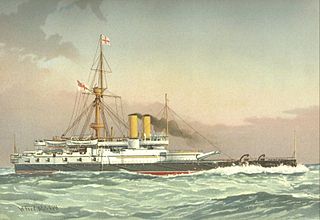
HMS Victoria was the lead ship in her class of two battleships of the Royal Navy. On 22 June 1893, she collided with HMS Camperdown near Tripoli, Lebanon, during manoeuvres and quickly sank, killing 358 crew members, including the commander of the British Mediterranean Fleet, Vice-Admiral Sir George Tryon. One of the survivors was executive officer John Jellicoe, later commander-in-chief of the British Grand Fleet at the Battle of Jutland.

HMS Sans Pareil was a Victoria-class battleship of the British Royal Navy of the Victorian era, her only sister ship being HMS Victoria.
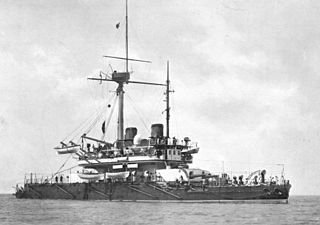
HMS Thunderer was one of two Devastation-class ironclad turret ships built for the Royal Navy in the 1870s. She suffered two serious accidents before the decade was out and gained a reputation as an unlucky ship for several years afterward. The ship was assigned to the Mediterranean Fleet in 1878 and was reduced to reserve in 1881 before being recommissioned in 1885. Thunderer returned home in 1887 and was again placed in reserve. She rejoined the Mediterranean Fleet in 1891, but was forced to return to the UK by boiler problems the following year. The ship became a coast guard ship in Wales in 1895 and was again placed in reserve in 1900. Thunderer was taken out of service in 1907 and sold for scrap in 1909.
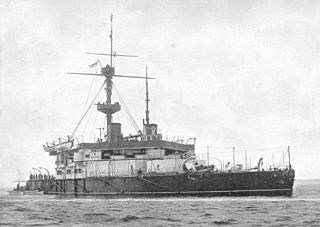
HMS Trafalgar was one of two Trafalgar-class battleships commissioned in 1890 and 1891, the other being HMS Nile. The ship was designed as an improved version of existing battleships with greater displacement and a thicker armoured belt amidships. Trafalgar saw active service as a battleship from 1890 to 1897 and from 1909 to 1911 when she was sold. Between these two periods as a combatant, Trafalgar served as a guardship and as a drill ship.

HMS Alexandra was a central battery ironclad of the Victorian Royal Navy, whose seagoing career was from 1877 to 1900. She spent much of her career as a flagship, and took part in operations to deter the Russian Empire's aggression against the Ottoman Empire in 1878 and the bombardment of Alexandria in 1882. She was affectionately known by her crew as Old Alex.
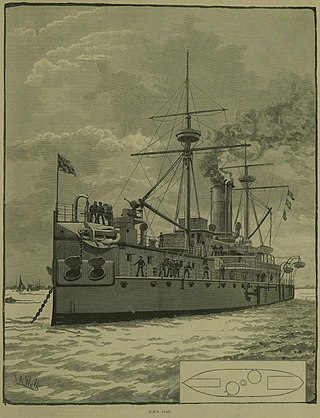
HMS Ajax was the name ship of her class of ironclad battleships built for the Royal Navy during the 1870s. Completed in 1883, she was immediately placed in reserve until 1885 when the ship was commissioned for the first time. Later that year, Ajax was assigned as a coast guard ship in Scotland and remained there for the next six years. She was reduced to reserve again in 1891 and was taken out of service a decade later. The ship was sold for scrap in 1904 and subsequently broken up.

HMS Collingwood was the lead ship of her class of ironclad battleships built for the Royal Navy during the 1880s. The ship's essential design became the standard for most of the following British battleships. Completed in 1887, she spent the next two years in reserve before she was assigned to the Mediterranean Fleet for the next eight years. After returning home in 1897, the ship spent the next six years as a guardship in Ireland. Collingwood was not significantly damaged during an accidental collision in 1899 and was paid off four years later. The ship was sold for scrap in 1909 and subsequently broken up.
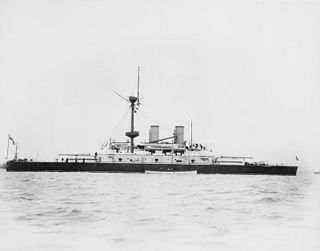
HMS Howe was an Admiral-class ironclad battleship built for the Royal Navy during the 1880s. The ship was assigned to the Channel Fleet in mid-1890 and was badly damaged when she ran aground in late 1892. After repairs were completed, Howe was transferred to the Mediterranean Fleet in late 1893. She returned home in late 1896 and became a guardship in Ireland. Howe remained there until late 1901 when she was assigned to the Reserve Fleet. The ship was paid off in three years later and then sold for scrap in 1910.

HMS Anson was the last of six Admiral-class ironclad battleships built for the Royal Navy during the 1880s. The ship was completed, except for her armament, in 1887, but had to wait two years for her guns to be installed. She was assigned to the Channel Fleet in mid-1889 as a flagship for the fleet's second-in-command. Two years later, the passenger ship SS Utopia sank with the loss of 562 lives after colliding with Anson in the Bay of Gibraltar. In mid-1893, Anson was transferred to the Mediterranean Fleet, subsequently returning home in 1900 when she was assigned to the Reserve Fleet. She recommissioned for the Home Fleet in early 1901. Anson was paid off three years later and then sold for scrap in 1909.
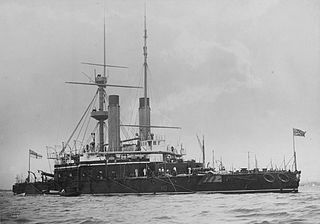
HMS Nile was one of two Trafalgar-class ironclad battleships built for the Royal Navy during the 1880s. Late deliveries of her main guns delayed her commissioning until 1891 and she spent most of the decade with the Mediterranean Fleet. Nile returned home in 1898 and became the coast guard ship at Devonport for five years before she was placed in reserve in 1903. The ship was sold for scrap in 1912 and broken up at Swansea, Wales.

HMS Revenge was one of seven Royal Sovereign-class pre-dreadnought battleships built for the Royal Navy during the 1890s. She spent much of her early career as a flagship for the Flying Squadron and in the Mediterranean, Home and Channel Fleets. Revenge was assigned to the International Squadron blockading Crete during the 1897–1898 revolt there against the Ottoman Empire. She was placed in reserve upon her return home in 1900, and was then briefly assigned as a coast guard ship before she joined the Home Fleet in 1902. The ship became a gunnery training ship in 1906 until she was paid off in 1913.

HMS Repulse was one of seven Royal Sovereign-class pre-dreadnought battleships built for the Royal Navy in the 1890s. Assigned to the Channel Fleet, where she often served as a flagship, after commissioning in 1894, the ship participated in a series of annual manoeuvres, and the Queen Victoria's Diamond Jubilee Fleet Review during the rest of the decade. Repulse was transferred to the Mediterranean Fleet in 1902 and remained there until December 1903, when she returned home for an extensive refit. After its completion in 1905, Repulse was assigned to the Reserve Fleet until she was sold for scrap in 1911.

HMS Royal Sovereign was the lead ship of the seven ships in her class of pre-dreadnought battleships built for the Royal Navy in the 1890s. The ship was commissioned in 1892 and served as the flagship of the Channel Fleet for the next five years. She was transferred to the Mediterranean Fleet in 1897 and returned home in 1902, and was briefly assigned as a coast guard ship before she began a lengthy refit in 1903–1904. Royal Sovereign was reduced to reserve in 1905 and was taken out of service in 1909. The ship was sold for scrap four years later and subsequently broken up in Italy.
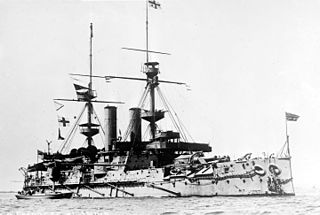
HMS Empress of India was one of seven Royal Sovereign-class pre-dreadnought battleships built for the Royal Navy during the 1890s. The ship was commissioned in 1893 and served as the flagship of the second-in-command of the Channel Fleet for two years. She was transferred to the Mediterranean Fleet in 1897, during which time Empress of India was assigned to the International Squadron blockading Crete during the uprising there. She returned home in 1901 and was briefly assigned as a coast guard ship in Ireland before she became the second flagship of the Home Fleet. The ship was reduced to reserve in 1905 and accidentally collided with the submarine HMS A10 the following year. Empress of India was taken out of service in early 1912 and accidentally struck a German sailing ship while under tow. She was sunk as a target ship in 1913.

HMS Royal Oak was one of seven Royal Sovereign-class pre-dreadnought battleships built for the Royal Navy during the 1890s. Upon her completion in 1894, she was initially placed in reserve until mobilised in 1896 for service with the Flying Squadron. After returning briefly to reserve, the ship was assigned the following year to the Mediterranean Fleet. Royal Oak remained there until 1902 when she returned home; after a refit, the ship was assigned to the Home Fleet, where she served as the flagship of the fleet's second-in-command in 1904–05. Royal Oak was then reduced to reserve until she was taken out of service in 1911. The ship was sold for scrap in early 1914.
